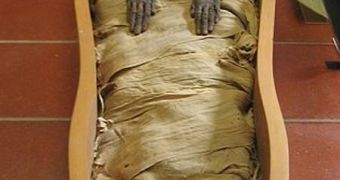The Lahun pyramid was first discovered and excavated about a century ago, but, thus far, the mud-brick-built structure has revealed little significant secrets. On Sunday, however, the head of the excavations at the 4,000-year-old site announced that a cache of mummies had been discovered, each neatly buried in its linens and in brightly colored wooden coffins. The team that made the find said that more discoveries were very likely to follow, and expressed their amazement that no one had found anything similar at the location in the past as well. The structure was built during the reign of the 12th dynasty pharaoh Senusret II.
“The tombs were cut on the rock itself, and they vary in architectural designs. Most of the mummies we discovered were with these bright and beautiful colors,” the leader of the excavation team, archaeologist Abdul Rahman Al-Ayedi, explained, as quoted by Reuters.
He added that skulls were first discovered at the site, and that they were carefully removed from their tomb, in order to make way for the digging team. Over the last two days, the archaeologists have been working around the clock to unearth as much of the cache as possible.
The workers were amazed to discover that the coffins that had not been busted into, or otherwise damaged by thieves, were painted in very bright and beautiful hues of white, red and green, and that they were in almost mint condition. The team also discovered that the tomb they excavated was, in fact, built on top of graves from previous eras, and that the site, located some 60 kilometers (35 miles) South of Cairo, was laden with mummies.
Some 30 of the ones extracted so far have been well preserved, and Al-Ayedi hopes that they could potentially provide some insight into how funerary customs and mortuary architecture evolved throughout Egypt's history, from the Middle Pharaonic Kingdom to the Roman times. There are dozens of tombs dotting the landscape around the Lahun pyramid, and the archaeologists said that they would continue to dig, in hopes of finding even more preserved bodies in the sands.
Al-Ayedi also announced that his team's finds might soon challenge the belief that the pyramid was 4,000 years old, on account of some mysterious information he found written on some newly discovered limestone tablets. “The prevailing idea was that this site has been established by Senusret II, the fourth king of the 12th dynasty. But in light of our discovery, I think we are going to change this theory, and soon we will announce another discovery,” the expert told in a news briefing.
“The size of the site is huge. So I thought that we could unearth a lot of elements in this site. At the beginning of the excavation, I thought that we may rewrite the history of the area, and I was right,” he concluded.

 14 DAY TRIAL //
14 DAY TRIAL //